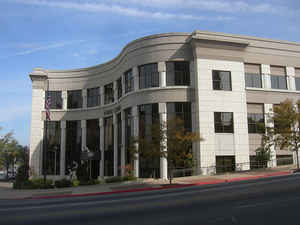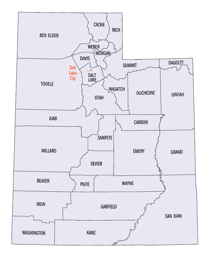Utah Counties
There are twenty-nine counties in the State of Utah. There were originally seven counties established under the provisional State of Deseret in 1849: Davis, Iron, Sanpete, Salt Lake, Tooele, Utah, and Weber. The Territory of Utah was created in 1851 with the first territorial legislature meeting from 1851-1852. The first legislature re-created the original counties from the State of Deseret under territorial law as well as establishing three additional counties: Juab, Millard, and Washington. All other counties were established between 1854 and 1894 by the Utah Territorial Legislature under territorial law except for the last two counties formed, Daggett and Duchesne.Weber County, Utah
Weber County Education, Geography, and History

Weber County is a county located in the state of Utah. Based on the 2010 census, the population was 231,236, making it the fourth-most
populous county in Utah. Its county seat and largest city is Ogden, the home of Weber State University. The county was formed in 1850 and
named after the Weber River.
Weber County is part of the Ogden-Clearfield, UT Metropolitan Statistical Area as well as the Salt Lake City-Provo-Orem, UT Combined
Statistical Area.
Etymology - Origin of Weber County Name
The county was formed in 1850 and named after the Weber River, which in turn was named for John Henry Weber (1779–1859), a fur trapper and trader in the area in the mid-1820s.
Demographics:
County QuickFacts: CensusBureau Quick Facts
Weber County History
Weber County has long been the
crossroads of Utah and the Intermountain West. Its eastern boundary is the spine
of the Wasatch Mountains with their towering peaks and sharp valleys. It extends
to the west into Great Salt Lake. Both mountains and flatlands are laced by the
Ogden and Weber rivers and their tributaries.
Nomadic Shoshone, Ute, and prehistoric Indians favored the area for centuries,
hunting in the mountains and foothills and fishing in the streams. Mounds near
the confluence of the Weber and Ogden rivers contain remains of their camps.
American and British mountain men entered the area in the early 1800's, trapping
beaver and trading with the Indians. Famed Jim Bridger became in 1824 the first
white man to report sighting Great Salt Lake. Peter Skene Ogden traversed the
high valley just behind the Wasatch Front in 1825 and is remembered in the name
of the area's largest city--although he never visited the actual site. The first
accurate maps of the area were drawn by John C. Fremont after he visited the
mouth of the Weber River in 1843.
Permanent settlement began in 1843 when horse trader/trapper Miles Goodyear
built a fort and trading post on the banks of the Weber River, near where it
meets the Ogden River. Late in 1847 he sold his claim to James Brown, a veteran
of the Mormon Battalion, for $1,950 in gold coins, and the property became
Brown's Fort, also known as Brownsville. Within three years the community had
1,141 residents and its name was changed permanently to Ogden and the
surrounding area designated as Weber County.
Growth accelerated in 1869 when the nation's first transcontinental railroad was
completed on May 10 at Promontory Summit, 60 miles northwest of Ogden, but the
junction for transfer of rolling stock, passengers, and freight was quickly
moved to more conveniently located Ogden, nicknamed "Junction City". Other
industries established included woolen mills, canneries, livestock yards, flour
mills, breweries, iron works, banks, hotels, and telephone, telegraph, and power
companies. Ogden inventor John M. Browning patented in 1879 a new single-shot
rifle - the first of more than 100 firearms developed by the Brownings and sold
all over the world.
Weber County's next sizeable population explosion came just before and during
World War II when the military built Defense Depot Ogden in northern Weber
County and Hill Air Force Base and the Naval Supply Depot in nearby Davis
County. DDO and Hill continue to provide many jobs for Weber residents. The war
also placed increased demands on the transportation network, and nearly 150
regular and special trains moved through Ogden's Union Station on many days in
1944.
Weber County has definitely entered the space age. A number of aerospace
industries have offices and other facilities there, and manufacturing plants
produce powerful, miniature jet engines for aircraft and missiles and Jetway
loading bridges for airports worldwide. Weber State College with some 11,000
students, the US Forest Service regional headquarters, the IRS Service Center,
and the McKay-Dee and St. Benedict's hospitals are among the county's major
employers in the 1980s.
*Sources. Beehive History 14: Utah Counties. 1988 Utah State Historical Society, 300 Rio Grande, Salt Lake City, UT 84101-1182.
Geography: Land and Water
The county extends from high in the Wasatch Range in the east into a portion of the Great Salt Lake to the west.
The Weber and Ogden rivers and their tributaries run through its valleys. The Weber County Surveyor's office divides
the county into two regions, the "Lower Valley" and the "Upper Valley", divided by the ridge of the Wasatch front
range running north-south through the county. The "Lower Valley" is the more populous part of the county and is
adjacent to the Great Salt Lake. The "Upper Valley" is the eastern part of the county and consists mostly of the
Ogden Valley, the watershed of the Ogden River.
As reported by the Census Bureau, the county has a total area of 659 square miles (1708 km2), of which, 576
square miles (1491 km2) of it is land and 217 km2 (84 sq mi or 12.73%) is water.
Neighboring Counties
Bordering counties are as follows:
- Box Elder County, Utah (northwest)
- Cache County, Utah - (north)
- Rich County, Utah - (northeast)
- Morgan County, Utah - (south)
- Davis County, Utah - (south)
- Tooele County, Utah - (southwest - touch)
Education
Weber State University
Ogden-Weber Applied Technology College
Ogden City School District
Weber School District







